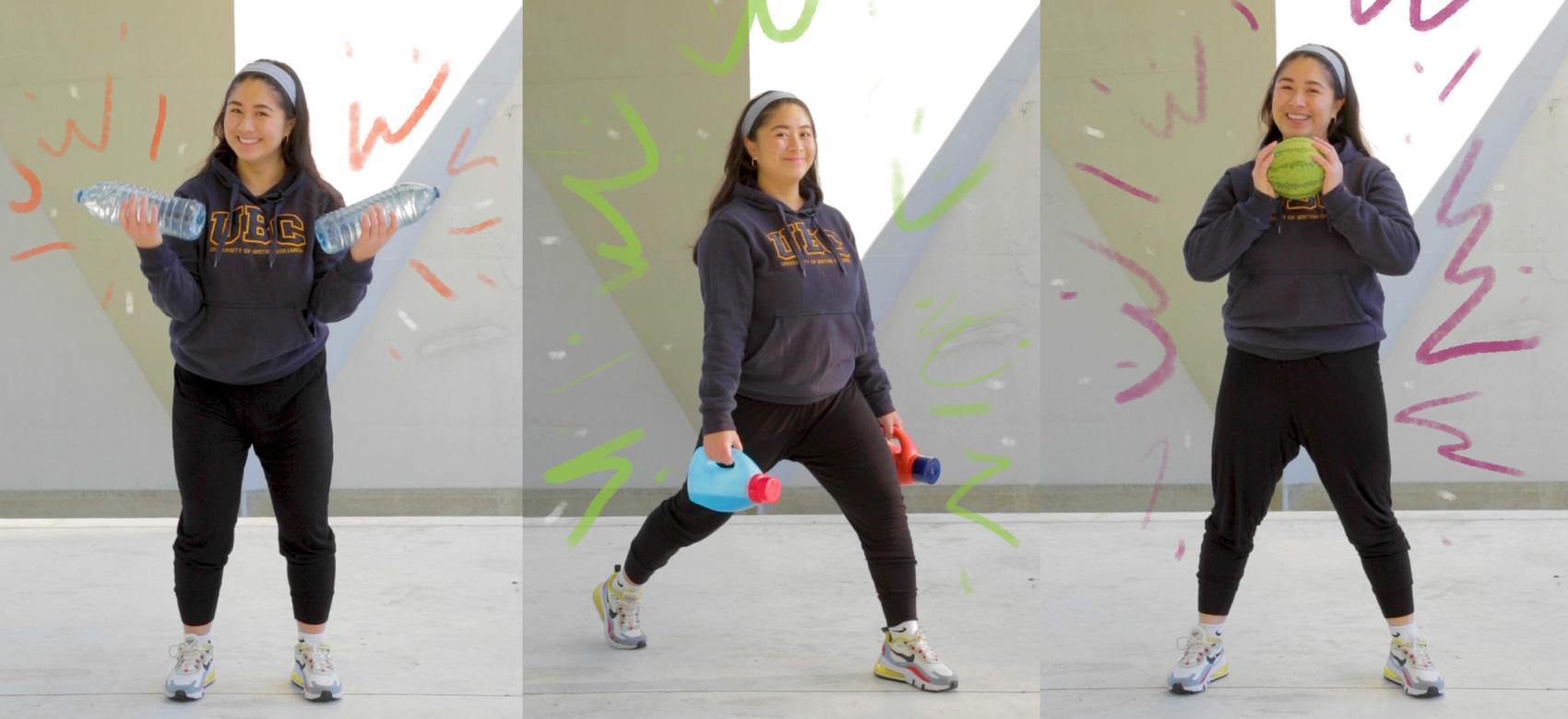How to work “exercise snacks” into your day
By Carolyn Ali

Short bouts of exercise add up and can help keep you fit, whether you spend your days at home or in the office
We hear you: it’s hard to get your exercise in the depths of winter. But you can still fit short bursts of activity into your day. Instead of carving out an hour to go to the gym, you can break off little bits of exercise to do throughout the day—exercise snacks—and still reap benefits.
University of British Columbia Okanagan researchers have studied the benefits of exercise snacks for people both at home and in the workplace. Their most recent study on the workplace highlights that getting up from your desk, taking a walk around the block or using the stairs instead of the elevator can go a long way in helping the health of sedentary workers.
“Moving more throughout the work day may not only improve physical health but also has the potential to positively impact mental health and work productivity,” says the study’s lead author, Dr. Matthew Stork, a former postdoctoral fellow at UBC’s School of Health and Exercise Sciences.
Here’s how Dr. Stork explains the concept of exercise snacks.
What is an “exercise snack”?
Exercise “snacks” grew out of the concept of high-intensity interval training (HIIT) and sprint interval training (SIT), in which you exert yourself for a short period, rest for a short period, and then repeat. These time-efficient workouts are usually done in bouts of about 10 to 25 minutes and have well-established physiological benefits.
Exercise snacks follow the same concept as high-intensity intervals, but with much longer rest periods. “It’s still brief bouts of exercise, but they’re spread throughout the day, typically from about an hour to four hours in between,” Dr. Stork says.
The advantage is that you can have an exercise snack whenever it works for you. “You’re not restructuring your day around exercise,” Dr. Stork explains. “You’re restructuring exercise into your day.”
Do exercise snacks really make a difference?
Yes, in several ways.
The first is aerobic fitness. “There’s limited but emerging evidence based on the physical benefits,” says Dr. Stork. He and his co-supervisors, Dr. Jonathan Little and Dr. Mary Jung, have been researching exercise snacks, building off their expertise in HIIT research.
In a lab study, Dr. Little’s research had one group of participants do traditional SIT on a stationary bike that consisted of three 20-second sprints separated by two minutes of rest in a single 10-minute session. Then another group of participants did the “exercise snacks” version of the same 20-second bouts separated by several hours, instead of several minutes, throughout the day. Following six weeks of training, the improvements to aerobic fitness were comparable between the SIT and exercise snacks groups.
Dr. Little also did a 2019 study in collaboration with McMaster University, which found that people can achieve fitness benefits from completing as little as three short bouts of vigorous stairclimbing activity throughout the day.
According to Dr. Stork, researchers used to believe that we needed a dedicated 10 minutes or more of time to get the benefits of physical activity, but some guidelines have evolved. While the Canadian guidelines differ, the latest Physical Activity Guidelines for Americans no longer suggest that a bout of activity needs to be at least 10 minutes long.
The second way exercise snacks benefit your health is that they simply increase the amount of activity in your day, and break up sedentary time. “Sedentary behaviour itself is linked to chronic health risks,” Dr. Stork points out. And moving more throughout the day not only helps your body feel better, it can improve productivity, concentration, creativity and more.
The latest UBCO research—supervised by Dr. Little and conducted with Dr. Jung and postdoctoral fellow Dr. Alexis Marcotte-Chénard—looked at how to incorporate exercise snacks in the workplace. Participants tried stairclimbing in the form of HIIT, completed within a single structured session, and exercise snacks, completed as isolated bouts spread throughout the day. Results showed that 71 per cent of participants preferred completing stair climbing in the form of exercise snacks compared to HIIT.
“The findings are encouraging because they indicate that exercise snacks, simply climbing three flights of stairs three times per day, might be an attractive way to increase physical activity and fitness in the workplace,” says Dr. Stork.

How long do I need to be active?
“It can be as little as 20 seconds to a minute,” Dr. Stork says, with the goal of elevating your heart rate. The more snacks you can do during the day the better, but something is better than nothing. “If you can do five bouts a day, that’s great. If you can do three, that’s great too. Do something that’s attainable and realistic for you.” Set goals in conjunction with your health care provider and get professional advice on activity that is appropriate for you.
Dr. Stork notes that you can build exercise snacks into your day while also doing a longer, structured workout, if that fits into your lifestyle.
Do I have to get sweaty?
No — not even if you’re wearing sweatpants.
“If you’re moving for about a minute, even though you’re getting your heart rate up, you’re not necessarily going to sweat,” Dr. Stork says. That’s an advantage, because it removes the barrier of changing clothes to prepare to exercise, and showering and changing back when you’re done.
If you’re working or studying at home, you’re likely wearing casual clothing to begin with so there’s another barrier to exercise removed. “It’s easier to just get up and do something.”
What are some examples of exercise snacks I can do?
Try bodyweight exercises like jumping jacks, push ups, jogging on the spot, lunges or squats. Check out UBC Recreation’s series of Movement Break videos for ideas. If you’ve got a set of stairs at home, walk up and down at a brisk pace for a minute to get the blood flowing, or go for a brisk walk around the block.
“We need to rethink the way we look at activity and exercise and get creative. Work with what you’ve got.”
Matthew Stork, UBC School of Health and Exercise Sciences
Strength-based exercise like lifting weights can also increase your heart rate, Dr. Stork says. If you don’t have weights, fill an empty milk jug with water and lift that. “We need to rethink the way we look at activity and exercise and get creative,” he says. “Work with what you’ve got.”
But you don’t even necessarily have to get your heart rate up. “Snacking could also be stretching or mobility based too,” he says. Do some simple stretches or grab a yoga mat and loosen up your body.
How can I motivate myself?
Dr. Stork recommends tracking your progress and planning digital prompts throughout the day to remind you that you’ve been sitting for an hour, for example, and it’s time for some activity. You can program a smart watch for reminders, download an app such as Stand Up! The Work Break Timer, or simply set reminders in your calendar.
For their ongoing research, the UBCO team has developed a web platform and Smartphone app for study participants, which provides custom notifications linking to videos with individualized exercise snacks and movement breaks. Funded by grants awarded to Dr. Little from the Canadian Cancer Society, Canadian Institutes of Health Research, and Diabetes Canada, these ongoing studies are testing if exercise snacks can be easily incorporated into the lives of people living with overweight, obesity and Type 2 diabetes.
Can I still have a real snack?
Of course!
“If you’re working nine to five, you would normally take coffee breaks and washroom breaks,” Dr. Stork says. “If you’re going to take a break and have a little snack, have a snack of activity too.”
Carolyn Ali is a writer for UBC Brand and Marketing. This article was updated on January 2, 2024, from its original publication on December 21, 2020. Feel free to republish the text of this article, but please follow our guidelines for attribution and seek any necessary permissions before doing so. Please note that images are not included in this blanket licence.


